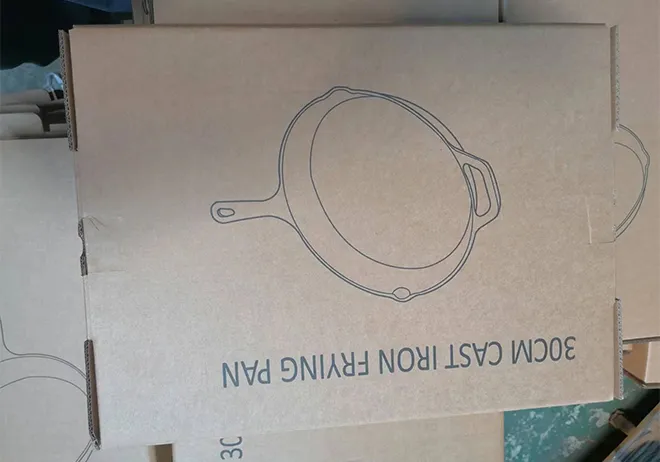
Feb . 11, 2025 23:07
Back to list
enameled cast iron vs regular
Understanding the differences between enameled cast iron and regular cast iron kitchenware is essential for anyone looking to invest in durable cooking tools. Both materials have their strengths, and knowing which one suits your cooking style is vital for making an informed purchase.
Enameled cast iron shines in terms of versatility. You can use it on a variety of heat sources, including induction, without worrying about damaging the material. The enamel is safe for use in the oven and even under the broiler, although manufacturers' guidelines should be followed to avoid potential damage. Regular cast iron is similarly versatile but requires careful handling when introducing it to high-temperature settings to maintain its seasoning and prevent warping. For cleaning, enameled cast iron is undeniably more straightforward. It typically allows for scrubbing and washing with soap without fear of stripping off seasoning or causing rust. This ease of care is a significant selling point for those who prefer low-maintenance cookware. Regular cast iron requires more attention; it should be hand washed in warm water and thoroughly dried to prevent rusting. Re-seasoning may be necessary occasionally but can be a rewarding process for those who enjoy traditional methods. Cost differences are also a deciding factor. Enameled cast iron cookware is often more expensive due to the additional materials and manufacturing process. However, its aesthetic appeal and ease of maintenance can justify the higher price tag for some consumers. Regular cast iron is typically more budget-friendly, offering a cost-effective option for those willing to invest time in proper care and seasoning. In conclusion, the choice between enameled and regular cast iron depends largely on personal preferences and cooking needs. Enameled cast iron offers convenience, style, and simplicity in care, making it suitable for those with a busy lifestyle who still want the benefits of cast iron without the need to maintain seasoning. Regular cast iron appeals to traditionalists and those who appreciate developing their cookware's naturally non-stick surface over time. Both materials are reliable additions to any kitchen, providing quality and versatility that professional and amateur chefs alike can trust. Understanding these nuances allows for a more informed decision, ensuring the selected cookware enhances your culinary endeavors.


Enameled cast iron shines in terms of versatility. You can use it on a variety of heat sources, including induction, without worrying about damaging the material. The enamel is safe for use in the oven and even under the broiler, although manufacturers' guidelines should be followed to avoid potential damage. Regular cast iron is similarly versatile but requires careful handling when introducing it to high-temperature settings to maintain its seasoning and prevent warping. For cleaning, enameled cast iron is undeniably more straightforward. It typically allows for scrubbing and washing with soap without fear of stripping off seasoning or causing rust. This ease of care is a significant selling point for those who prefer low-maintenance cookware. Regular cast iron requires more attention; it should be hand washed in warm water and thoroughly dried to prevent rusting. Re-seasoning may be necessary occasionally but can be a rewarding process for those who enjoy traditional methods. Cost differences are also a deciding factor. Enameled cast iron cookware is often more expensive due to the additional materials and manufacturing process. However, its aesthetic appeal and ease of maintenance can justify the higher price tag for some consumers. Regular cast iron is typically more budget-friendly, offering a cost-effective option for those willing to invest time in proper care and seasoning. In conclusion, the choice between enameled and regular cast iron depends largely on personal preferences and cooking needs. Enameled cast iron offers convenience, style, and simplicity in care, making it suitable for those with a busy lifestyle who still want the benefits of cast iron without the need to maintain seasoning. Regular cast iron appeals to traditionalists and those who appreciate developing their cookware's naturally non-stick surface over time. Both materials are reliable additions to any kitchen, providing quality and versatility that professional and amateur chefs alike can trust. Understanding these nuances allows for a more informed decision, ensuring the selected cookware enhances your culinary endeavors.
Previous:
Next:
Latest news
-
Premium Deep Cast Iron Pan – Versatile Enameled & Grill Options, Perfect for Frying and SaucesNewsJun.10,2025
-
Chipped Enamel Dutch Oven – Durable & Stylish Kitchen Essential for Even CookingNewsJun.10,2025
-
Best Cast Iron Cookware Set Sale Durable Pots & Woks DealsNewsJun.09,2025
-
Hanging Dutch Oven Oven Safe & Lid IncludedNewsJun.09,2025
-
16 Inch Dutch Oven - Heavy Duty Cast Iron for Large MealsNewsJun.09,2025
-
Premium Cast Iron Bacon Grill Press - Heavy-Duty & Even HeatingNewsJun.09,2025


